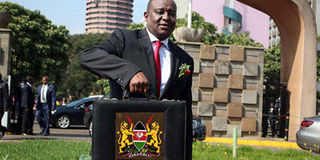Kenya eyes new bonds amid rising debt appetite

Treasury Cabinet Secretary Henry Rotich at Parliament Buildings on June 14, 2018 for budget reading. PHOTO | FILE | NATION MEDIA GROUP
What you need to know:
- Plans are underway to go back to international markets before the end of June to raise an estimated Sh250 billion in a new issue.
- The total public debt stood at Sh5.1 trillion by September last year, according to data from the Central Bank of Kenya.
- Opposition leader Musalia Mudavadi, a former Finance minister, urged Kenyans to pay attention to the ballooning debt that poses a risk to the economy.
Kenya will explore five new bonds among them the Chinese and Japanese as it moves to find alternatives for its insatiable appetite for debt to fund its ballooning budget.
In the budget summary for the 2019/20 financial year, the Treasury has revealed that the government intends to explore other sources of financing such as the Islamic financing instruments, the green, Samurai, Panda and diaspora bonds over the medium term.
In seeking the new financing options, the Treasury hopes to diversify sources of external debt and reduce over-reliance on the current lenders.
“The government will continue to diversify sources of financing over the medium term by maintaining a presence in the international capital markets,” the budget document reads.
Samurai are yen-denominated bonds usually issued in Tokyo by non-Japanese companies. These bonds are subject to Japanese regulations.
Panda are Chinese renminbi-denominated bonds designed to allow borrowers to tap into China’s large investor base.
EUROBOND
Kenya has been increasingly turning to China for debts to fund its infrastructure projects, which has seen China upstage Western countries to become Nairobi’s biggest lender.
Islamic financing instruments, also known as Sukuk bonds, seek to provide sharia-compliant capital and are popular in the Middle East, while green bonds target lenders keen on funding climate and environmental projects exclusively.
On their part, diaspora bonds target Kenyans living abroad. Usually, the bonds help migrants to receive discounts on government debt from their home countries.
Until now, the government has only been relying on Eurobonds, which have become popular under the Jubilee administration.
By the end of this financial year the government will have raised over Sh700 billion in Eurobonds, which mostly target investors from Western nations among them the United States and Europe.
Already, the country has raised Sh480 billion in two previous fundraisings.
DEFICIT
Plans are underway to go back to international markets before the end of June to raise an estimated Sh250 billion in a new issue.
In the new financial year that starts in the next two months, Kenya plans to spend Sh2.7 trillion in its budget.
But the country can only raise Sh2.1 trillion, leaving a deficit of Sh607.8 billion which it must fund through debt.
To get this money, the government will borrow Sh324.3 billion from external markets while Sh289.2 billion will be borrowed from the domestic market. The remaining Sh5.7 billion will come from other domestic receipts.
The total public debt stood at Sh5.1 trillion by September last year, according to data from the Central Bank of Kenya (CBK). Repayments have become a top three expenditure item for the government.
PUBLIC DEBT
In the new budget, the Treasury plans to spend a total of Sh551 billion in interest payments for loans and pension. This is Sh61 billion more than the Sh490 billion this year.
On Wednesday, Opposition leader Musalia Mudavadi, a former Finance minister, urged Kenyans to pay attention to the ballooning debt that poses a risk to the economy.
Despite continued pressure to put breaks on borrowing, the Treasury maintains that the country’s debt position is sustainable and that it has put in place robust measures to ensure it does not get out of hand.
“The external debt sustainability indicators illustrate that Kenya’s risk has increased from low to moderate, but this is expected to be short term as the government continues with its fiscal consolidation reform and implements liability management strategy aimed at restructuring short term commercial loans by replacing them with long dated maturities,” the budget document adds.
MIDDLE INCOME
The Treasury notes that though the country will continue to maximise external sources of loans on concessional terms, Kenya’s graduation to a lower middle income economy is slowing down access to these cheaper loans.
After rebasing the economy in 2014, Kenya acquired the middle income economy status. This status has come with various advantages but has also come with a fair share of disadvantages after it stopped being treated as a developing country.
“The government will aim at maximising the official external sources for loans on concessional terms, even though this source is shrinking,” the Treasury document says.
On the domestic debt, the government says Treasury bonds will remain the main source of domestic financing.





